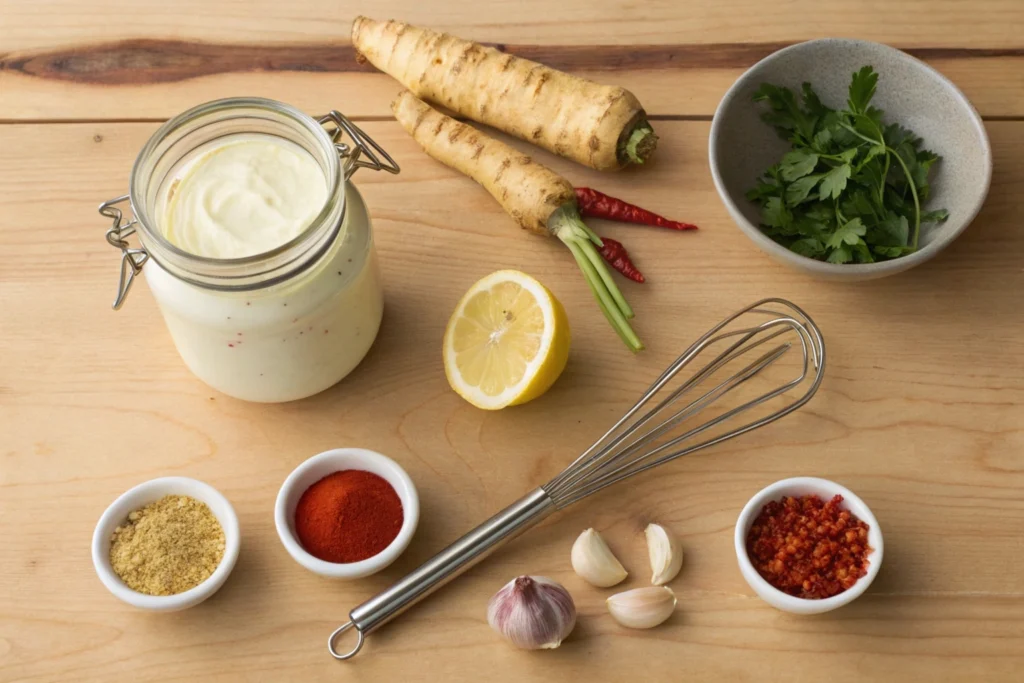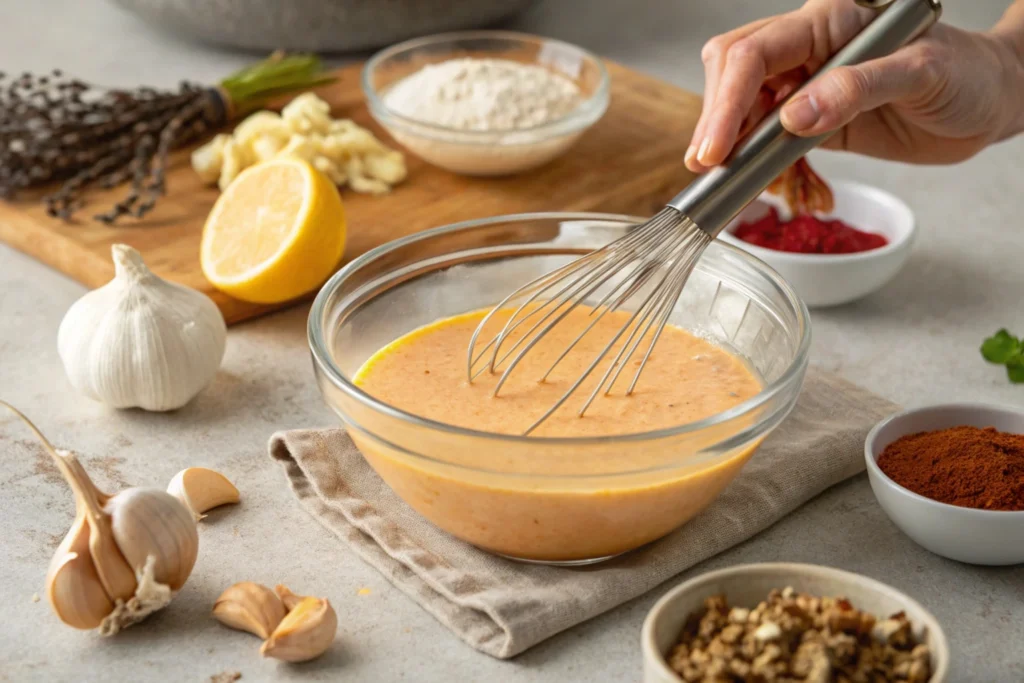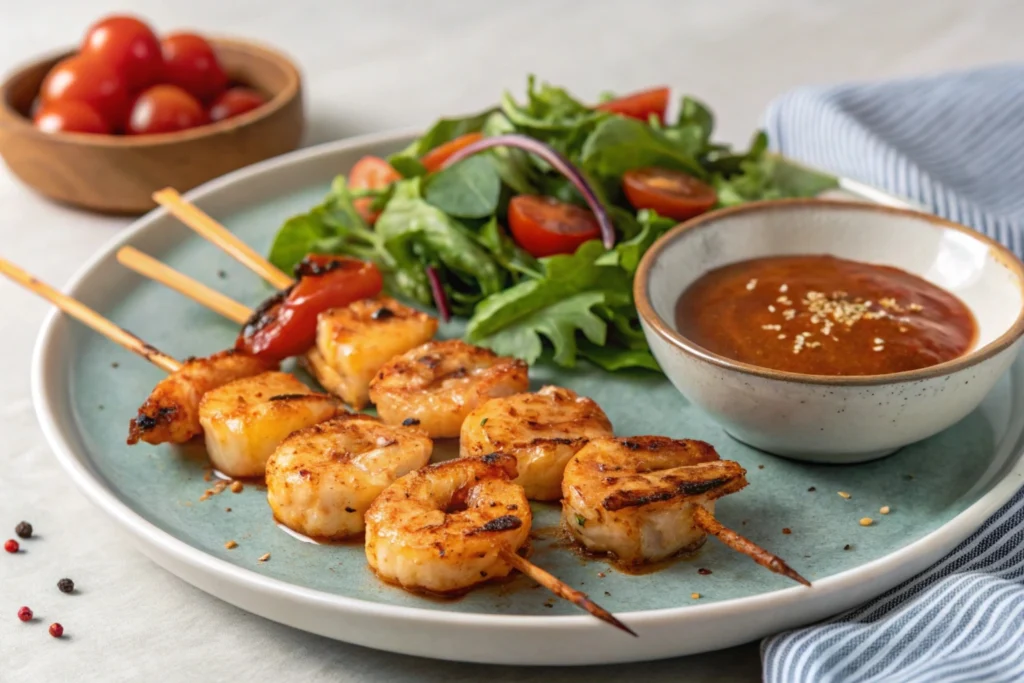Introduction
What is Tiger Sauce?
Tiger Sauce Recipe is one of those secret weapons in the kitchen that can elevate almost anything you’re eating. It’s a creamy, tangy, slightly spicy condiment that’s loved for its bold flavor and versatility. Originating in Southern cooking (where flavorful sauces are a way of life), it’s a staple for seafood, sandwiches, grilled meats, and even veggies. At its core, Tiger Sauce combines the smooth richness of mayonnaise with the spicy kick of horseradish, along with a medley of seasonings to bring it all together.
But here’s the fun part—it’s not just for dipping. Drizzle it over grilled shrimp, slather it on a burger, or even mix it into a potato salad for a surprising twist. It’s the kind of sauce that makes you say, “Where has this been all my life?”
What Makes Tiger Sauce Recipe a Must-Try?
Here’s the thing: store-bought Tiger Sauce is fine for convenience, but making it at home? That’s a game-changer. First, you get total control over the flavor. Want it fiery? Add extra horseradish or a dash of hot sauce. Craving something zesty? Go heavy on the lemon juice. By making it yourself, you can tweak the recipe to match your personal taste.
Another reason to go homemade? It’s fresh and free of preservatives or artificial flavors. You’ll know exactly what’s in it—and that’s a win for anyone who loves clean, simple ingredients. Plus, it takes less than 10 minutes to whip up! Whether you’re hosting a backyard barbecue or spicing up your weeknight dinner, this sauce will quickly become your go-to. Trust me, once you taste it, there’s no going back to the store-bought version.
Table of contents
Ingredients and Preparation
To make the best Tiger Sauce Recipe, you’ll need simple pantry staples. Start with mayonnaise as the creamy base, then add horseradish for heat, lemon juice for tang, and seasonings like cayenne and garlic. This Tiger Sauce Recipe is quick to prepare—just mix everything in one bowl, adjust the flavors to your liking, and serve.
Essential Ingredients for the Perfect Tiger Sauce Recipe
Making Tiger Sauce at home is all about balancing bold flavors with a creamy texture. Here’s what you’ll need to make it perfect every time:
1. Mayonnaise (The Creamy Base)
Mayonnaise forms the heart of Tiger Sauce, giving it that rich, velvety texture. It binds everything together and helps carry the flavors. Whether you use store-bought or make your own (if you’re feeling fancy), go for a high-quality mayo with a neutral flavor. Brands like Hellmann’s or Duke’s are fan favorites, but feel free to experiment. If you’re watching calories, light mayonnaise works too, but it might slightly alter the texture.
2. Horseradish (The Kick)
This is where Tiger Sauce gets its signature zing! You can use prepared horseradish for convenience, but if you want an extra punch of freshness, grate your own from a horseradish root. Just a tablespoon or two is usually enough to add heat without overwhelming the sauce. Can’t handle too much spice? Start small—you can always add more!
3. Additional Flavorings
- Garlic: Fresh minced garlic or garlic powder adds depth.
- Lemon Juice: A squeeze of fresh lemon brightens the flavor and balances the creaminess.
- Vinegar: A splash of white vinegar or apple cider vinegar adds tang.
These little touches give Tiger Sauce that addictive complexity that keeps people coming back for more.
4. Spices and Seasonings
To finish things off, you’ll need basic seasonings like salt and pepper. Add cayenne pepper for a hint of extra heat or paprika for a smoky undertone. If you’re feeling adventurous, try a dash of Old Bay seasoning—it pairs perfectly with seafood.
If you’re a fan of bold Southern flavors, you might also enjoy other tangy recipes like the Southern Cornbread with Beef Tallow.

How to Make Tiger Sauce Recipe Step by Step
Making Tiger Sauce at home is quick and simple. With just a handful of steps, you’ll have a creamy, tangy, and spicy sauce ready to elevate your meals. Let’s get started!
Step 1: Gather Your Ingredients
Before anything else, make sure you’ve got all your ingredients prepped and ready. This will save you from digging through your pantry mid-mixing (we’ve all been there). Grab your mayonnaise, horseradish, garlic, lemon juice, vinegar, and spices like cayenne, salt, and pepper. For tools, you’ll need a mixing bowl, a whisk (or spoon), and measuring spoons.
Step 2: Combine the Base Ingredients
In a medium-sized mixing bowl, start by adding 1 cup of mayonnaise. This will be your creamy foundation, so use the good stuff! Next, add 1–2 tablespoons of prepared horseradish (adjust based on your spice tolerance). If you’re using fresh horseradish, grate it finely to avoid chunky bits.
Now, add your acidic elements: 1 tablespoon of fresh lemon juice and 1 teaspoon of white vinegar. These ingredients add a tangy brightness that balances out the richness of the mayo.
Step 3: Add Flavor Boosters
Time to amp up the flavor! Add 1 clove of minced garlic (or ½ teaspoon of garlic powder if you’re in a pinch). Sprinkle in ¼ teaspoon of cayenne pepper for heat and a pinch of smoked paprika for a subtle smoky flavor. Season with salt and freshly cracked black pepper to taste. If you’re feeling creative, toss in a dash of Old Bay or even a few drops of hot sauce for an extra kick.
Step 4: Mix it Up
Whisk everything together until the sauce is smooth and creamy. Make sure there are no clumps of horseradish or garlic lurking around—you want the flavors to meld evenly. This part is oddly satisfying, so don’t rush it.
If the sauce feels too thick, add a splash of water or an extra squeeze of lemon juice to thin it out. Keep mixing until you get your desired consistency.
Step 5: Taste and Adjust
Here’s the fun part: grab a spoon and give it a taste! This is your chance to tweak the flavors. Want more heat? Add a pinch of cayenne or another teaspoon of horseradish. Need more tang? A little more vinegar or lemon juice will do the trick.
Pro tip: Let the sauce sit for 10–15 minutes before serving. This allows the flavors to develop and blend beautifully.
Step 6: Serve
Perfect as a dip for Chicken and Shrimp Stir Fry or as a drizzle over roasted veggies.
Step 7: Store It Properly
Transfer your Tiger Sauce into an airtight container or a mason jar. It will stay fresh in the refrigerator for up to 5 days. Be sure to give it a stir before each use, as some ingredients might separate over time.Serve: Perfect as a dip for Chicken and Shrimp Stir Fry or as a drizzle over roasted veggies.

Variations and Serving Suggestions
Popular Variations of Tiger Sauce
One of the best things about this Tiger Sauce Recipe is how versatile it is. Customize it to fit your favorite dishes: add hot sauce for more spice, honey for sweetness, or yogurt for a lighter option. Serve this Tiger Sauce Recipe as a dip, drizzle, or marinade—it pairs perfectly with seafood, chicken, veggies, or even fries!. Here are some popular ways to switch it up:
- Spicy Tiger Sauce: If you love heat, crank it up! Add an extra teaspoon of horseradish or a dash of your favorite hot sauce (Sriracha works great). For a fiery twist, try blending in minced jalapeños or chili flakes.
- Smoky-Sweet Version: Blend in honey and smoked paprika for a barbecue-inspired sauce. It pairs well with hearty dishes like Beef Arm Roast.
- Creamier Variation: Want something extra rich? Mix in 2–3 tablespoons of sour cream or Greek yogurt. It tones down the spice slightly and gives the sauce a thicker texture—perfect as a dip.
- Zesty Tiger Sauce: Love citrus? Add the zest of a lemon or lime for a brighter, fresher taste. This version is especially great with seafood like shrimp or crab cakes.
Serving Ideas
Tiger Sauce is ridiculously versatile. Here are a few ways to serve it that’ll make your meals unforgettable:
- As a Dip: Serve it alongside fried shrimp, chicken tenders, or crispy fries. It’s a crowd-pleaser at parties and game nights.
- For Sandwiches and Burgers: Spread it on burgers, deli sandwiches, or even wraps for a flavor-packed upgrade. It’s especially amazing on roast beef sandwiches.
- With Grilled Meats: Drizzle it over grilled chicken, steak, or ribs. The tangy and creamy combo works wonders with smoky, charred flavors.
- Seafood Pairing: Use it as a topping for crab cakes, a dip for lobster tails, or even a sauce for fish tacos. If you’re exploring seafood recipes, consider the delectable Crab Brulee for an elevated pairing.
- Salad Dressing: Thin it out with a bit of olive oil or water, and toss it with your favorite salad greens for a quick, tangy dressing.
- Veggie Drizzle: Roasted or steamed veggies like asparagus, broccoli, or Brussels sprouts get a major flavor boost with a drizzle of Tiger Sauce.

Nutritional Information
Curious about the nutritional breakdown? Here’s what you can expect from a homemade batch of Tiger Sauce:
- Calories: Approximately 70 calories per tablespoon (mostly from mayonnaise).
- Fats: Around 7 grams, with most coming from healthy oils in mayo.
- Carbohydrates: Minimal—less than 1 gram per serving.
- Protein: Nearly zero unless you add yogurt or sour cream.
Healthier Swaps:
If you want to lighten it up, swap regular mayonnaise for a low-fat or vegan option. You can also use Greek yogurt instead of mayo for a higher-protein version. To reduce calories, skip the sweeteners (if you’re making a smoky-sweet variation).
FAQs :
1. What is Tiger Sauce made of?
Tiger Sauce typically consists of a creamy base like mayonnaise, combined with horseradish for a spicy kick. Other ingredients include lemon juice or vinegar for tanginess, garlic for depth, and seasonings like salt, pepper, and cayenne for extra flavor. Some versions may include sweeteners like honey or smoked paprika to add complexity.
2. What can I use in place of Tiger Sauce?
If you don’t have Tiger Sauce on hand, you can create a substitute with similar ingredients. Mix mayonnaise with a small amount of horseradish and a splash of hot sauce or cayenne for spice. Alternatively, a mix of aioli and prepared horseradish can work. For a lighter option, combine Greek yogurt with mustard, garlic, and chili flakes to mimic the tangy and spicy flavor profile.
3. What is Copeland’s Tiger Sauce?
Copeland’s Tiger Sauce is a signature condiment served at Copeland’s restaurants, known for its bold, zesty flavor. It’s a creamy sauce made with mayonnaise and horseradish, similar to traditional Tiger Sauce, but with a unique balance of spice and tanginess that complements Copeland’s Cajun-inspired dishes like fried seafood and steaks.
4. Is Tiger Sauce like Sriracha?
Not exactly! While both have bold flavors, Tiger Sauce and Sriracha are quite different. Tiger Sauce is creamy and tangy, with a mild to medium heat that comes from horseradish. Sriracha, on the other hand, is a thick, spicy chili sauce with a garlicky, sweet heat. If you mix Sriracha into mayonnaise, it could resemble a spicier, chili-forward version of Tiger Sauce.
Conclusion
So there you have it—homemade Tiger Sauce Recipe! This creamy, tangy, and spicy sauce is proof that simple ingredients can create magic. Use it to drizzle on grilled shrimp, dunk fries, or spread on your favorite sandwich—it’s versatile and always delicious.
Making it at home lets you customize it to your taste. Want more heat? Add extra horseradish or cayenne. Prefer a zesty kick? Squeeze in more lemon juice. Plus, it’s preservative-free, so you can feel good about it.
This sauce isn’t just a dip—it’s also great as a marinade, salad dressing, or sandwich spread. Best of all, it takes under 10 minutes to make.
Now it’s your turn! Gather your ingredients, mix up a batch, and get creative. If you love bold flavors, bookmark this recipe or share it with a friend. Ready to make your Tiger Sauce? Let’s do it!
